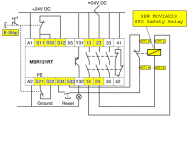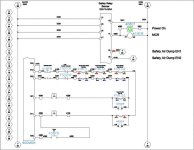Welcome back Matt,
Matt said:
...I need a safety relay to monitor two estops and also will be connected in series through several SEW MOVAXIS drives. ( built in safety contacts)...
...I have began reading the information on the AB website and several others as well.
I am having trouble with how to interact my safety relay with the built in relay in the drives. They have a dedicated safe relay and coil for same...
Have you, or others, done any kind of a Risk Analysis for this safety design?
It sounds like they are MXA81's? These have one Safe Torque Off (STO) safety relay, incorporating a coil and one normally closed feedback contact. Having only one built in safety relay they will do up to Category 3 PL d.
I don't know what your controlling with these servos, but they support group disconnection, so you can possibly do this using one safety relay,
but, first you need to decide the stop category required.
If an Emergency Stop is activated, is it safe to do an uncontrolled stop, stop category 0, of all the servos?
If a safe stop, stop category 1, is required on one or more of the servos, then you cannot use group disconnection, and will require a safety relay incorporating a delay off for each stop category 1 servo.
If you are using safe stop category 1, upon emergency stop activation, the safety relay delays triggering the STO. Before this delay times out, you must drive the servo to a stop using a brake ramp specified via setpoints. Because the brake deceleration is not monitored by the safety function, you have to be very careful that if the servo has not fully decelerated when the STO is triggered, there may be a potential risk to persons. Your Risk Analysis should take this into consideration.
If you only require stop category 0, then group disconnection will make this relatively simple to setup.
Depending on how many servos you want to add to the safety relay, each servo STO relay coil consumes up to 950mW, so make sure the safety relay's contacts can handle this.
I have used an Allen Bradley MSR121RT(Cat no. 440R-J23102) SIL 3, Cat. 4, PL e safety relay before for a similar job to yours.
Whether PILZ, AB, or what ever, use a dual channel safety relay, with at least two instantaneous safety contacts(stop category 0). It must have manual monitored reset. Both emergency stops should have dual contacts to wire the safety relays dual channels through.
It's better to break both the positive and the negative going to the STO relays through the safety relay. This method also prevents having to wire the STO relay supply and feedback in separate cables.
So wire the 24VDC supply for the servos STO safety relay positive and negative through the instantaneous safety relay contacts and in to X7:1(24VDC+) and 2(24VDC-) on the first servo. You can then loop this to each subsequent servo STO safety relay. You must use the normally closed feedback contact from each servo(X7:3,X7:4), wired in series, with the manual monitored reset circuit. Do not use automatic reset on the safety relay.
If the safety relay has an non safety auxiliary contact, you can also wire a safety relay status input to a PLC.
I've attached a rough drawing of how you would connect one emergency stop and one SEW MOVIAXIS STO safety relay to an MSR121RT.
For two emergency stops, just wire both channels in series through both stops.
Channel 1 = S11,S12
Channel 2 = S21,S22
For more than one servo, wire the STO coils, X7:1 and X7:2, all in parallel and the feedback contacts, X7:3 and X7:4, all in series with the reset circuit S33 and S34.
Any questions, ask away.
G.







